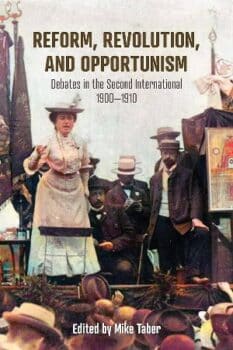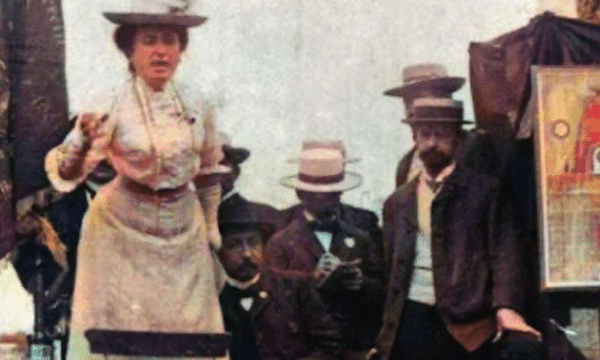The founding of the Second International, the organisation grouping together Social Democratic and Labour parties, in 1889 represented a major step forward for socialism. It brought together these parties under the banner of Marxism and with a formal commitment to revolution. Its founding resolution declared:
‘The emancipation of labour and humanity cannot occur without the international action of the proletariat—organised in class-based parties—which seizes political power through the expropriation of the capitalist class and the social appropriation of the means of production’ (p.2).

Reform, Revolution, and Opportunism: Debates in the Second International, 1900—1910, ed. Mike Taber (Haymarket Books 2023), 272pp.
As a body, it would champion the fight for the eight-hour day, state insurance and pensions, votes for women and the right to asylum, and while these were reforms which would not destroy capitalism, it believed the struggle to win such demands would increase the power of the working class and bring it nearer to its self-emancipation. We owe the existence of our May Day celebrations and of International Women’s Day to the Second International in 1889 and 1910 respectively.
Above all, its founding helped in the creation of mass Social Democratic and Labour parties. Looking at the Labour Party of Sir Keir Starmer and Anas Sarwar, or the governments led by Olaf Scholz in Germany or Pedro Sánchez in Spain, you might say ‘big deal’. But at the time, the creation of mass parties, capable of winning millions of votes, and with a commitment to socialism, marked a major step forward.
Working-class women and men asserted their own identity against the boss class, and those with votes no longer had to vote for openly pro-capitalist parties; in Britain in the late nineteenth century trade-union leaders backed the Liberal Party and that’s for whom their members voted. This changed after the Taff Vale judgement of 1901, which allowed companies to sue unions for ‘damages’ caused by strike action, and the Osborne judgement, which outlawed unions having political funds. Unions then switched allegiance to the newly formed Labour Party.
Prior to August 1914 and the outbreak of the First World War, Lenin looked to the biggest party of the Second International, the German Social Democratic Party (SPD) as the model he was following. He still saw the International’s key intellectual, Karl Kautsky, as the leading Marxist.
All that changed utterly with the war, when the SPD and their sister parties lined up with their ‘own’ states and encouraged their members and supporters to join the colours in order to kill their brothers across the front line. But that lay in the future: prior to August 1914, Lenin and Rosa Luxemburg believed that the Second International was the agent of revolution and that it was committed to revolutionary action to stop any such war in its tracks.
Four Congresses
These are the years of four congresses of the International—Paris 1900, Amsterdam 1904, Stuttgart 1907 and Copenhagen 1910—and of high-level debates on five crucial issues—socialist participation in capitalist governments, colonialism, immigration, women’s suffrage and militarism and war. These debates are all covered in this marvellous book.
What becomes clear is that opportunist elements had emerged within the different parties. Some defended the French Social Democrat, Alexandre Millerand, who, in 1899, took a ministerial post in a government formed of pro-capitalist parties, and whose war minister had been responsible for executing thousands in the bloody suppression of the 1871 Paris Commune. Other elements defended colonialism on clearly racist grounds, opposed non-white immigration, or downplayed the growing movements for votes for women. Finally, there were those who believed war could be averted by international agreements on arms limitation and by international courts of arbitration.
Lenin, Luxemburg and other revolutionaries could take comfort from the fact that these elements did not carry the day, and so these four congresses adopted positions which were formally correct. On colonialism, however, the vote at the 1907 Stuttgart was staggeringly close, 127 for an anti-colonial position, but with 108 against and ten abstentions.
In editing and providing introductions to the book as a whole and the different debates, Mike Taber brings alive the issues and the contrasting positions. Those issues echo down into today’s world, as different as it may seem superficially. The fundamental problem for the Second International, which Taber identifies, is that while resolutions might back the revolutionary overthrow of capitalism, there was no clear strategy for achieving it. Thus, the division between reform and revolution became a constant at these congresses, and was never resolved prior to August 1914.
The other weakness he notes is that the International was an organisation essentially restricted to the capitalist states of Europe, North America and Australia (a delegate from Japan attended and contributed at the 1907 Stuttgart congress). Otherwise, there were some delegates from Argentina, South Africa (a white who opposed migration from Asia), and Turkish Armenia, plus one individual supporter of Indian independence, who addressed that same Stuttgart Congress.
One important absence, I feel, was James Connolly, the great Irish socialist who clearly saw the need to fight for Irish independence. But from 1903-1910, he was in the USA and involved in the Industrial Workers of the World, whose syndicalism and support for direct action meant they were never involved in the Second International.
Anti-imperialism and war
Anti-imperialism, consequently, was never a central concern of the Second International, despite the efforts of Luxemburg, Lenin and their supporters. This was important because much of the opposition to militarism and war was based on moral and pacifist objections, and many of those who took that stance collapsed into supporting war in 1914 because of the supposed barbarism of Russian Tsarism or German autocracy. They did not see war as flowing from international competition and imperialism, and that it provided an opportunity for the working class to turn imperialist war into civil war.
In the debates on colonialism, the supporters of ‘socialist colonialism’, which would bring civilisation to the ‘natives’, were openly racist. In his contribution, Ramsey MacDonald outdid himself. Speakingat the Stuttgart Conference ‘in the name of the Labour Party,’ he said this: ‘Most British colonies are inhabited by British people, who have established free states that possess complete autonomy, with some having their own parliaments’ (p.73).
Even MacDonald must have been aware that simply was not true in India, or in other British possessions across Asia, Africa and the Caribbean. Tiny British elites ran these colonies with no reference to the vast majority of their population. Vicious repression met any opposition. Only the white-run Dominions of Canada, Australia, New Zealand and South Africa had parliaments. In South Africa the whites were a minority. MacDonald did not admit, or perhaps was too stupid to be aware, they were built on the brutal suppression of their native peoples and their cultures.
Rosa Luxemburg opposed all of this with great clarity. She was the front person for the revolutionary wing because she was a far more well-known figure than Lenin. Their supporters included Clara Zetkin from Germany, Karl Radek, Julian Marchlewski and Henryk Walecki from Poland (all three were later killed by Stalin in the Great Purges).
At the Stuttgart conference, again, a resolution was passed calling for qualified independence for the colonies. Luxemburg, Lenin and Martov successfully proposed an amendment which went further and called for unqualified independence, further adding this had to be won by the oppressed themselves. The majority, epitomised by Kautsky, championed a formal orthodoxy, but increasingly saw their task as holding the International together. So the resolution passed in regard to militarism and war at Stuttgart in 1907, which was toughened up at Copenhagen in 1910, after Austria’s annexation of Bosnia, seemed even to Lenin to be satisfactory.
The Copenhagen resolution promised ‘united action’ to stop a European war and reiterated the call from Stuttgart three years before that:
‘In case war should break out notwithstanding, they shall be bound to intervene for its speedy termination and to employ all their forces to utilise the economic and political crisis created by the war in order to rouse the masses of the people and thereby hasten the downfall of capitalist class rule.’
But the conclusion from Copenhagen was:
‘For the proper execution of these measures, the Congress directs the [International Socialist] Bureau, in the event of war danger, to take immediate steps to bring about an agreement among the labour parties of the countries affected for united action to prevent the threatened war’ (p.171).
There were two problems. The resolutions do not spell what ‘united action’ meant: a general strike, for example? By referring the matter to the International Socialist Bureau, any initiative passed to leaders of the major parties far distanced from revolutionary initiatives. They failed, decisively, the test of August 1914.
Votes for Women
The debate on Women’s suffrage at Stuttgart in 1907 followed an international socialist women’s conference held on the eve of the gathering, organised by the German Socialist Women’s Movement, in which Clara Zetkin was a key figure. It championed the fight for women’s suffrage. At the International Congress, this was opposed from two directions. First, by members of the British Fabian Society and the Independent Labour Party who supported votes for women only for those who met property qualifications. Secondly, by the Austrian Social Democrats who formally supported universal male suffrage, but saw that as the main fight and support for women’s suffrage as a ‘diversion’.
In reply, Clara Zetkin rose to the occasion, concluding her contribution thus:
‘Socialist women must fight energetically in this campaign for political equality and do their utmost to involve masses of proletarian women in the effort. By doing so, they will demonstrate that it is the masses of women themselves who demand the right to vote, and that proletarian women are willing to use this right. Let us step forward without hesitation to fight for women’s suffrage. Doing so will help raise proletarian women to class consciousness, which is of the highest significance for the present and future of the proletariat and its struggle for liberation’ (p.119).
Marvellous stuff. It’s worth getting this book for just this debate. But there is so much of value here, which speaks to us in today’s world. Read it!
Chris Bambery is an author, political activist and commentator, and a supporter of Rise, the radical left wing coalition in Scotland. His books include A People’s History of Scotland and The Second World War: A Marxist Analysis.

